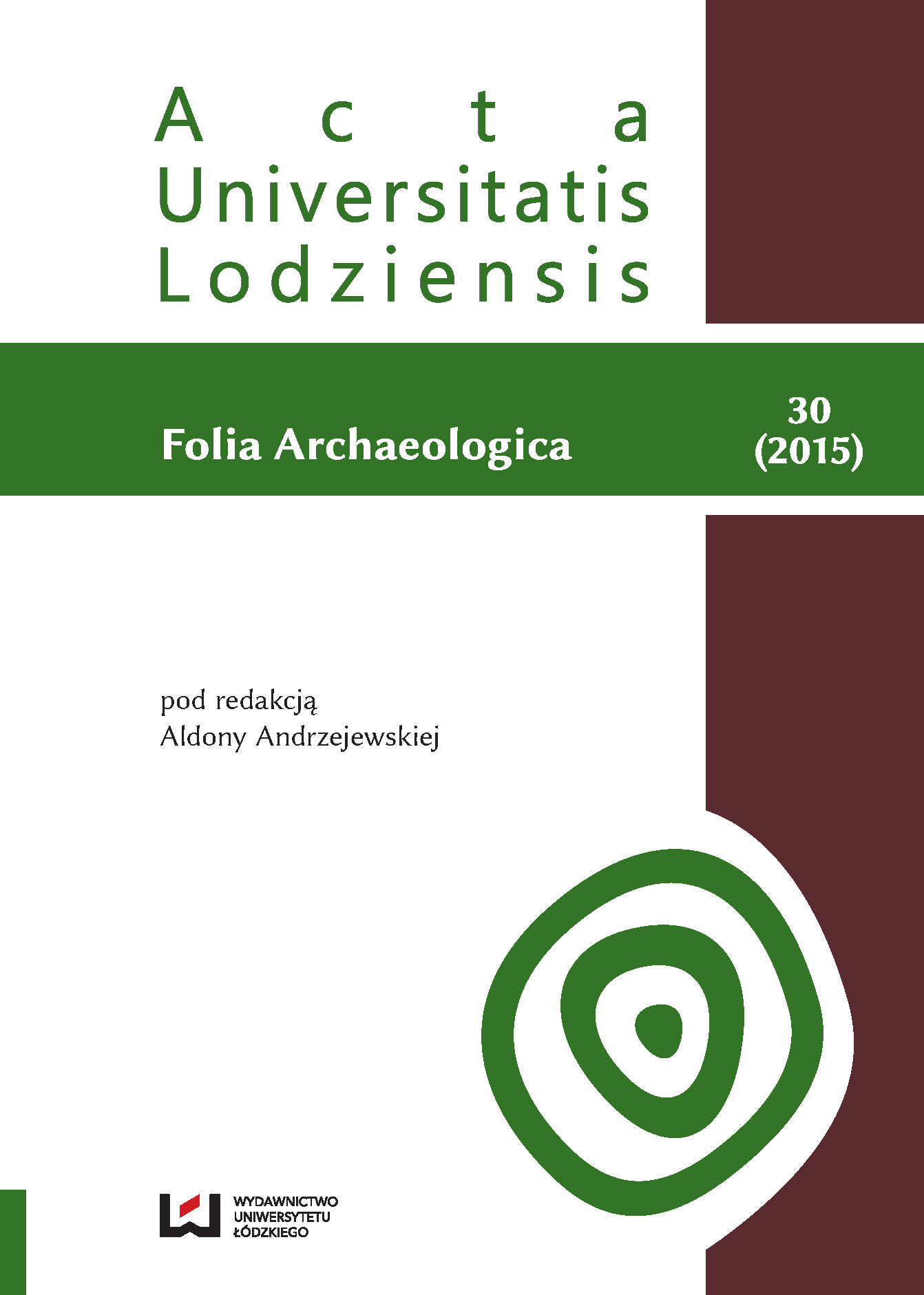„Kochankowie z Ain Sakhri” w kontekście aktualnych badań nad kultem płodności na terenie Palestyny
DOI:
https://doi.org/10.18778/0208-6034.30.04Słowa kluczowe:
kult płodności, figurki antropomorficzne, Palestyna, rytuały religijneAbstrakt
The main purpose of this article is to demonstrate the possible continuity between early Palestinian cults reconstructed from anthropomorphic figurines and later beliefs. Figurines from the major archeological cultures including: Kebarian, Natufian or Yarmukian indicate a common ceremony of religious character, possibly connected with the cult of fertility. In this contexts particularly noteworthy is so-called „Ain Sakhiri Lovers” figurine which is unique and interpreted as showing a sexual intercourse. By presenting some of the types of early Palestinian anthropomorphic figurines, the author would like to discuss possible connections between earliest artifacts of probable religious meaning with documented religious systems.
Pobrania
Bibliografia
Allen D. (2002), Myth and Religion in Mircea Eliade, Routledge, London.
Google Scholar
Bar-Yosef O. (1998), The Natufian Culture in the Levant, threshold to the Origins of Agriculture, „Evolutionary Anthropology”, vol. 6, no. 5, s. 159–177.
Google Scholar
Ben-Shlomo D. (2010), Philistine Iconography: A Wealth of Style and Symbolism Academic Press Fribourg, Vandenhoeck & Ruprecht, Gättingen.
Google Scholar
Bieliński P. (1985), Starożytny Bliski Wschód. Od początków gospodarki rolniczej do wprowadzenia pisma, PWN, Warszawa.
Google Scholar
Boyd B., Cook J. (1993), A reconsideration of the „Ain Sakhri” figurine”, „ Proceedings of the Prehistoric Society”, 59, s. 399–405.
Google Scholar
Byrd B. F. (1989), The Natufian: Settlement Variability and Economic Adaptations in the Levant at the End of the Pleistocene, „Journal of World Prehistory”, vol. 3, no. 2, s. 159–197.
Google Scholar
Cauvin J. (2000), The Birth of the Gods and the Origins of Agriculture, Cambridge University Press, Cambridge.
Google Scholar
Eliade M. (1988-1995), Historia wierzeń i idei religijnych, T. 1–3, Instytut Wydawniczy PAX, Warszawa.
Google Scholar
Hayden B. (rec) (2002), Cauvin J., The Birth of the Gods and the Origins of Agriculture, „Canadian Journal of Archaeology / Journal Canadien d’Archéologie”, vol. 26, no. 1, s. 80–82.
Google Scholar
Kirk G. S. (1973), Myth: Its Meaning and Functions in Ancient and Other Cultures, University of California Press, Berkeley, s. 255.
Google Scholar
Leick G. (1991), A dictionary of ancient Near Eastern mythology, Routledge, London.
Google Scholar
MacGregor N. (2011), A History of the World in 100 Objects, Penguin PG, New York.
Google Scholar
Mazar A. (2000), The Temples and Cult of the Philistines, [in:] The Sea Peoples and Their World, ed. E. Oren, University Museum Monographs, b. 108, University of Pennsylvania Museum of Archaeology and Anthropology, s. 213–232.
Google Scholar
McMahon A. (2005), From Sedentism to States, 10, 000–3000 BCE, [in:] A companion to the ancient Near East, red. D. C. Snell, Wiley-Blackwell, Oxford, s. 20–33.
Google Scholar
Munro N. D. (2003), Small game, the younger dryas, and the transition toagriculture in the southern Levant, „Mitteilungen der Gesellschaft für Urgeschichte”, 12, s. 47–72.
Google Scholar
Munro N. D. (2004), Zooarchaeological Measures of Hunting Pressure and Occupation Intensity in the Natufian. Implications for Agricultural Origins, „Current Anthropology”, vol. 45, Supplement, August–October, s. 5–33.
Google Scholar
Nęcka E., Orzechowski J., Szymura B. (2006), Psychologia poznawcza, Academica Wydawnictwo SWSP, PWN, Warszawa.
Google Scholar
Sauer J. A. (1982), Syro-Palestinian Archeology, History, and Biblical Studies, „The Biblical Archaeologist”, Vol. 45, No. 4, s. 201–209.
Google Scholar
Schmandt-Besserat D. (1998), A Stone Metaphor of Creation, „Near Eastern Archaeology”, vol. 61, no. 2, s. 109–117.
Google Scholar
Shariff A. F., Norenzayan A., Henrich J. (2009), The Birth of High Gods How the Cultural Evolution of Supernatural Policing Influenced the Emergence of Complex, Cooperative Human Societies, Paving the Way for Civilization, [in:] Evolution, culture, and the human mind, eds. M. Schaller, A. Norenzayan, S. J. Heine, T. Yamagishi, T. Kameda, Psychology Press, New York-London.
Google Scholar
Śliwa J. (1997), Sztuka i archeologia starożytnego Wschodu, PWN, Warszawa–Kraków.
Google Scholar
Verhoeven M. (2004), Beyond Boundaries: Nature, Culture and a Holistic Approach to Domestication in the Levant, „Journal of World Prehistory”, Vol. 18, No. 3, s. 179–282.
Google Scholar
Yasur-Landau A. (2001), The Mother(s) of all Philistines? Aegean Enthroned Deities of the 12th-11th Century Philistia, [in:] Aegaeum 22. Potnia, deities and religion in the Aegean Bronze Age. Proceedings of the 8th International Aegean Conference/8e Rencontre égéenne internationale, Göteborg University, 12–15 April 2000, eds. R. Laffineur, R. Hägg, Université de Liège, University of Texas at Austin, Liege.
Google Scholar
Pobrania
Opublikowane
Jak cytować
Numer
Dział
Licencja

Utwór dostępny jest na licencji Creative Commons Uznanie autorstwa – Użycie niekomercyjne – Bez utworów zależnych 4.0 Międzynarodowe.












